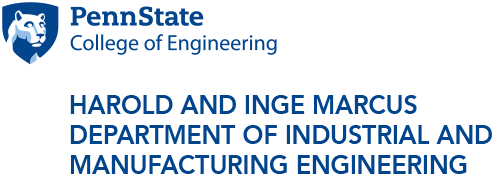
Rakshith Badarinath discovered the field of additive manufacturing in the fall of 2014 through an introductory course offered in the Harold and Inge Marcus Department of Industrial and Manufacturing Engineering.
Additive manufacturing and design master's program awards first degree
9/25/2017
UNIVERSITY PARK, Pa. — The Penn State Additive Manufacturing and Design Masters’ Program (AMD) has graduated its first student, Rakshith Badarinath.
Introduced in 2017, the AMD program offers a one-year master of science in additive manufacturing (AM) and design and master of engineering in additive manufacturing and design, educating students and working engineers to become technical experts in additive manufacturing and design, both in residence at Penn State University Park or online via Penn State World Campus.
Badarinath, who is also earning his doctorate in industrial engineering, discovered the field in the fall of 2014 through an introductory AM course offered in the Harold and Inge Marcus Department of Industrial and Manufacturing Engineering.
“After that one class, I was hooked,” he said. “I started taking every course related to AM offered at Penn State and then jumped at the chance for this master’s degree.”
AMD lies at the intersection of several engineering fields, inspiring technological innovations and re-thinking solutions for manufacturing. To capitalize on this, the program integrates graduate coursework across multiple departments, including the Departments of Mechanical and Nuclear Engineering; Industrial and Manufacturing Engineering; Engineering Science and Mechanics; School of Engineering Design, Technology, and Professional Programs; and Materials Science and Engineering; and across two colleges — the College of Engineering and the College of Earth and Mineral Sciences.
“It’s common for engineers to think in certain ways depending on their background and concentration,” he said. “But with this AMD degree, you’re at the intersection of many disciplines and can get a comprehensive picture of the issues in the field. This will help analyze the process and troubleshoot problems more easily.”
Working on his industrial engineering degree in tandem, Badarinath created a robotic testbed that is retrofitted with sensors to monitor the additive manufacturing process.
"The control system is used to closely monitor the process in real-time and detect any abnormalities before they can negatively affect the part being built,” he explained.
This exploration is needed because, “Currently, if you’re manufacturing a part, you won’t know if its failed until it’s done,” he said. “My current research is in modeling and monitoring the polymer additive manufacturing process, installing sensors and equipment so I can know if something is going wrong as it’s being built.”
As AM continues to redefine how objects are created, industries as varied as health care and consumer goods are beginning to harness its power.
“One of the great things about it is design freedom,” Badarinath said. “You can model anything in your software and produce it. The technology is definitely going to grow even more in the coming years.”
He added that AM offers many attractive opportunities for trained engineers. These can include light weighting of parts, creating complex internal structures, and consolidating assemblies into a single part.
With its rapid expansion, the AMD program now has more than 60 enrolled students through its World Campus and resident program.
Looking to the future, the graduates of this program are increasingly poised for success.
“Our students are getting exposure and hands-on experience on the cutting edge of AM,” said Tim Simpson, the Paul Morrow Professor of Engineering Design and director of the AMD program. “When they arrive in industry, they’re going to bring a unique skillset that will help position them as leaders in this rapidly changing field.”
Badarinath agreed and said, “AM is the future.”



